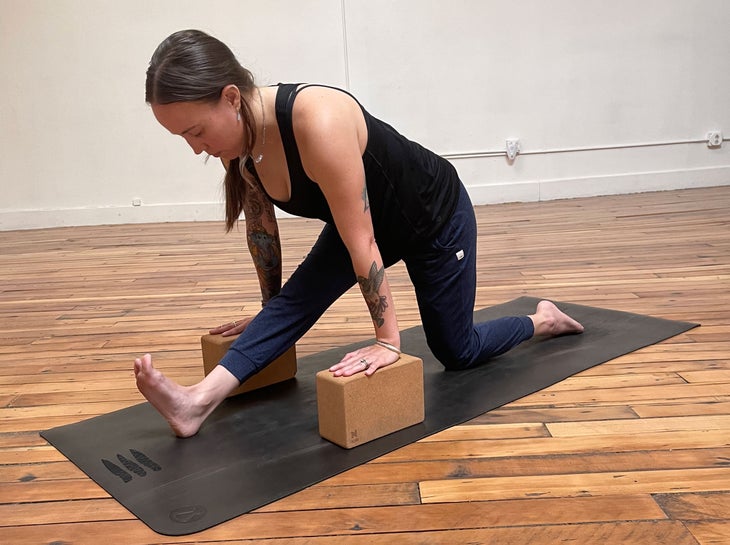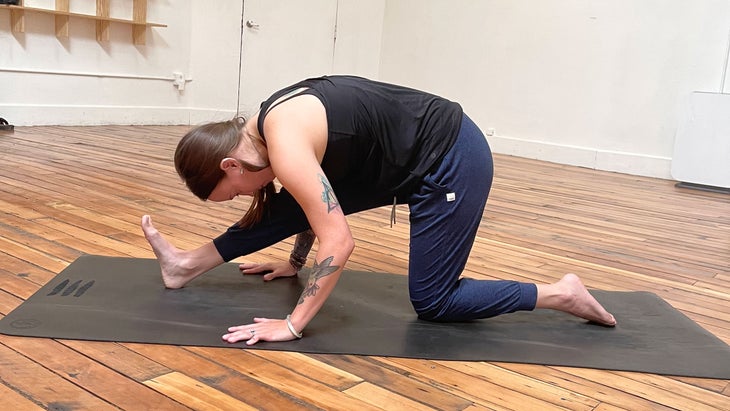Heading out the door? Read this article on the new Outside+ app available now on iOS devices for members! Download the app.
On paper, Ardha Hanumanasana (Half Splits) seems like a relatively straightforward pose. In real life, though, there’s a lot happening here. Whenever I teach this pose, I see students look around class with that “what the?” expression, hoping to find someone else who knows what they’re doing so they can mimic them, only to find other blank looks of confusion.
Half Splits demands an intense hamstring stretch on your front leg. It also requires a balancing act on your back leg. And, while you’re juggling those two things, the pose asks you to reach your hands to the mat while keeping your back straight. Uh, no problem.
There’s no need to engage in the blame or shame game here. Your anatomy is going to determine how Half Pose looks and feels in your body. For some, Half Splits is a comfortable stretch. For others, that hamstring stretch might feel impossibly intense, which means your body will automatically adjust its alignment somewhere else to compensate.
And this is where we experience problems—not because you’re unable to find the elusive “full expression” of the pose, but because these unconscious compensations can cause strain on your body and compromise the shape of the pose, which means you won’t receive its intended benefits.
That is, unless you become aware of what you’re doing so you can modify your approach accordingly.

How to come into Half Splits
Start in Tabletop Pose. Step your right leg in between your hands, coming onto your fingertips or bringing your hands to blocks if you need. Begin to straighten your right leg, wiggling your right heel forward to lengthen and stretch the back of your right leg. Flex your front foot, drawing your toes toward your chest. You want to feel a stretch but not a strain along the back of your front leg. You can keep as much of a bend in your front knee as you need. Lengthen your back.
Common misalignments in Half Splits
Following are the four most common misalignments I see students make in class—along with ways to help you find support for your body in each one.

1. You’re not using blocks beneath your hands
Why it’s a problem: The most common challenge with Half Splits is that the floor is simply too far away for your fingertips or palms to reach the mat, which can result in feeling unsteady at best. It can also cause a domino effect of all of the following issues as your body tries to find balance.
How to fix it: Bring the ground closer to you by using blocks (aka limb extenders) beneath your hands. This will allow you to lengthen your back body because you won’t need to round your spine or slide your hips backward or off to the side in an attempt to bring your hands to the ground.

2. Your hips are too far back
Why it’s a problem: Perhaps the mosts essential thing to keep in mind is to stack your hips over your bent knee. However, when you have tight hamstrings, the tendency is to shift your seat too far back.
Think of this as brakes in your car. If your hips are your breaks, each time you shift them back toward your heels, you’re easing off the accelerator, which is the intense sensation in your straight leg hamstring. But then you lose a lot of the stretch in that leg.
How to fix it: To see if this is your tendency, begin in Half Splits with your left knee bent. Bring your left hand to the back of your left thigh and feel for the angle of bend in your left knee. If you have a 90-degree angle between your hamstring and calf, then chances are your alignment is stable. If you have less than that, chances are you’ve probably leaned too far back.
If this is the case, you might need to shimmy your right foot further away from you so that you can shift your hips a little forward into alignment above your back knee. This allows you to come into the pose from a place of strength and stability, even if that means bending your front knee a little and not stretching the hamstrings quite as dramatically.

3. You’re rounding your spine instead of stretching your straight leg
Just because your forehead is close to your right shin, doesn’t mean you’re stretching your hamstrings! It’s kinda an optical illusion. You’d think that because your face is closer to the ground, you’re in a more advanced version of the pose. Nothing could be further from the truth.
No one tells you this, but you don’t need to completely straighten your forward leg! If the stretch has become too much on your forward leg, give your right knee a slight bend to ease the stretch in your calf while still targeting your hamstring.
Once you’re in Half Splits and you’ve stacked your hips over your left knee, notice where your forehead is in relation to your shin. Think of your spine as a wire support on a bridge. If the wire is straight, it has more stability than a curved and lax wire. If you’re rounding to get your forehead closer to your shin, lengthen your spine by energetically pulling the crown of your head away from your tailbone. At the same time, energetically pull your right heel in the same direction as your tailbone without actually moving it. This will create more leverage for you to access the stretch in your hamstring!
Once again, focusing on creating a strong base, and then allowing that to help you access your greatest mobility, will help you set yourself up for success in this pose as well as more technical asanas.

4. Your hips are lopsided
Once you’ve stacked your hips over your bent left knee and lengthened your spine, check to see if your left hip is jutting out towards the side of the mat. If it is, pull your left hip (your hip joint is in the back of your pelvis, where the femur is attached to your hip socket) toward the back of your mat. If your hips aren’t in alignment, this will cause you to lose your balance.
Remember, Half Splits has a balancing component! It’s easy to lose engagement by collapsing into your left hip. This happens when you haven’t engaged your stabilizer muscles, aka your hip abductors. These muscles draw your leg bones into your hip sockets to create stability in your pelvis.
About our contributor
Ashlee McDougall is a self-proclaimed yoga nerd. She’s completed more than 1,500 hours of yoga teacher training with expert teachers including Janet Stone and Jason Crandell. She enjoys creating sequences that help you build strength and mobility and is passionate about offering trauma-aware and inclusive classes. You can follow her on Instagram at @Ashlee.McDougall and take class with her at Yoga Loft in Tucson, Arizona.